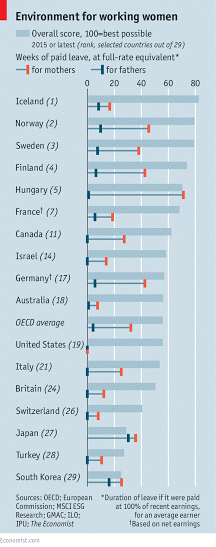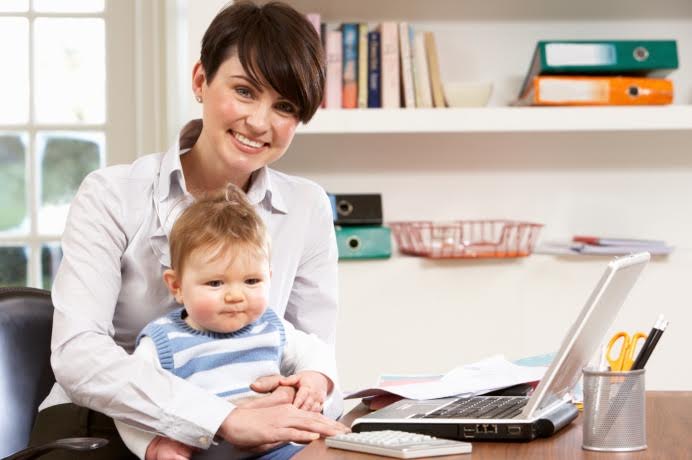Finland, Norway and Sweden are the top 3 countries for working women
The Nordic countries — Iceland, Norway, Sweden and Finland — are the best countries to be a working woman, according to The Economist’s glass-ceiling index 2016.
In these countries, women are present in the labour force at similar rates to men. Finland has the largest share of women who have gone through higher education compared with men (49% of women have a tertiary degree, and 35% of men). Norway’s gender wage-gap (6.3%) is less than half the OECD average (15.5%).
Researchers used data from the World Economic Forum’s “Gender Gap Report,” the OECD, and other sources to measure how well the world’s top economies have “leveraged their female talent pool.”
The ‘glass-ceiling index’ compiled data on higher educations, level of labour force participation, salary, child-care benefits, maternity rights, business school applications and representation in senior jobs. Paternity rights were also included to draw comparisons between the opportunities and benefits for both genders.
The UK, the US and Germany all fall below the OECD average and the top of the list is made up predominantly of Scandinavian countries.
At the bottom of the ranking are Japan, Turkey and South Korea, where men are more likely than women to have degrees, to be in the workplace and to hold senior positions. Their pay gap is also wide.
10 Best Countries to be a working woman
These are 10 best countries in the world for working women:
10) New Zealand
With the lowest gender wage gap — 5.6% — it’s no wonder Australia’s neighbour ranked so highly. An impressive 40% of women make up its senior or managerial positions. Women working full-time in New Zealand earn, on average, about 5.6 per cent less than men, the smallest gap among 34 OECD countries, according to 2013 statistics.
9) Belgium
After New Zealand, Belgium had the second smallest gender wage gap at just 6.4%. Belgium has a high percentage of children in formal childcare. Belgium offers different kinds of parental leaves, career-breaks to both parents to facilitate work-life balance. There also numerous family benefits for parents.
8) Spain
Around 41.1% of Spain’s parliament is made up of females. The highest figure after Finland, 42%, and Sweden, 43.6%. Turkey and Spain, for example, both offer 16 weeks’ maternity leave, but in Spain new mothers receive 100% of salary whereas in Turkey it is just 66%.
7) Denmark
Women in Denmark earn just 7.8% less than their male counterparts, one of the best results in the report. The Danish family policy prioritizes the principle of a ‘dual-earner’ family and the system thereby supports equal rights between women and men. The Danish parental leave system is among the most generous and flexible in the EU. Mothers are entitled to 4 weeks of maternity leave before the expected date of birth and 14 weeks of maternity leave after the birth.
6) Hungary
Around 43% GMAT exams taken in Hungary are completed by women, while an impressive 40.4% of senior managerial positions are occupied by women. Since 2000, Hungary has had a family-friendly workplace award to give recognition to companies and institutions that have introduced measures facilitating a better work-life balance among employees.
5) France
In France, women make up 39% of senior or managerial positions, and just under 29% of company board members. Involving fathers in undertaking responsibilities once the child is born constitutes a key aspect to avoid gaps between gender and career development, in France
4) Poland
Poland came out on top in the maternity leave stakes. Women are given 22 weeks off work, fully paid. In Poland, 53% of women have jobs which is less than the OECD average of 58% however Poland has generally been successful in addressing the constraints and barriers women face accessing work.
3) Sweden
Sweden had the highest proportion of female members of parliament — 43.6% — while net childcare costs accounted for just 5.8% of the average woman’s salary. Swedish parents are among the EU’s most successful in balancing work and family responsibilities as the aim of the Swedish financial family policy is to improve living standards for all families with children and to promote equality in parenthood between women and men.
2) Norway
The Scandinavian country was knocked from the top spot this year, but it still performed well. Almost 40% of its members of parliament are female while 31% of senior managerial positions were filled by women. Norway’s laws also require at least 40% of all public limited company board members be female.
1) Finland
Of all the countries analyzed in the report, Finland had the highest share of women in higher education and the largest female labour-force participation. 83% of women, even mothers, work full time, thanks in part to the country’s system of public childcare and free school meals. At 68% in 2014, Finland has one of the highest female employment rates in EU. Thanks to strong state support for children and families, parents can focus on families while keeping their jobs secure. Finland also offers access to public day care for all children under seven and a generous system of family leave and allowances.



